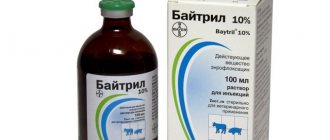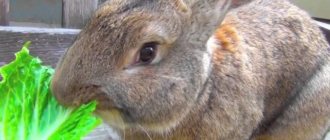What should be in a rabbit breeder's first aid kit?
The composition should include the following groups of funds:
- Dressing material for treating wounds: bandages;
- cotton wool;
- napkins;
- gauze;
- cotton pads;
- cotton buds;
- syringes;
- chlorine;
- immunobiological preparations;
Conventions, symbols and examples of decoding.
The alphabetic and numerical designations indicated in the table are widely used by medical specialists. I will give their meaning.
IM (intra_muscular) intramuscular PO orally SC (sub_cutaneous), subcutaneous injections DW (drinking water), with drinking water IV (intra_venous) intravenous injections sid once a day bid twice a day tid three times a day eod every day wkly once per week tsp teaspoon cups dust cap q8–12h every 8-12 hours use with caution use carefully
A SIMPLE EXAMPLE: Amikacin 2–5 q8–12h SC,IM means that the antibiotic Amikacin is used for rabbits: from 2 to 5 milligrams per kilogram of weight, every 8-12 hours, by subcutaneous or intramuscular injection. COMPLEX EXAMPLE: Enrofloxacin 5 –10 q12h PO,SC,IM or 200mg/L dw × 14d Enrofloxacin - from 5 to 10 milligrams per kilogram of weight, every 12 hours, orally (by mouth) or by subcutaneous injection or intramuscular injection. If with drinking water, then dilute 200 milligrams per 1 liter and drink it for 14 days, provided that the rabbit drinks 10% of its body weight per day.
How to prepare a rabbit for treatment
Rabbits are very timid animals. And any treatment for eared animals is a lot of stress and fright for them. This nuance should be taken into account before starting any therapy. Experienced breeders recommend preparing animals for upcoming treatment in the following way:
- start the procedure when the animal calms down and eats well;
- remove objects that could injure the animal;
- If the little ear is restless, you can wrap it loosely in a diaper, towel or piece of fabric.
Before using any product, you must carefully read the instructions for it and carefully study all the recommendations for using the drug. Incorrect treatment and failure to follow the instructions for use can lead to disastrous results.
- When feeding medications - tablets - it is allowed to use different methods: - giving directly from the hand (if the animal agrees to eat the medicine on its own); - hide the pill inside your favorite treat - then feed it; - crush the medicine to a powdery substance and mix with food; — dissolve the drug in water and feed the animal with it (unless this is prohibited by the instructions for use).
- Liquid medicine for oral administration is poured in using a pipette, syringe, or added to a drink (if you are sure that the animal will drink it).
- It is better to use drops, ointments, and powders after first immobilizing the rabbit (with the help of a partner or by wrapping it up).
Arguments against antibiotics.
I was interested to know the opinion of experienced rabbit breeders on this matter. In large and medium-sized farms, especially in breeding rabbit breeding, they try to stay away from antibiotics. The explanation is simple: there is no efficiency. As you know, bacteria adapt very easily to antibiotics. If, for example, you successfully selected the one you need from many existing ones, and got a good result in recovery, then the next time it will help little, and the third time its effect will be close to zero. You will have to select another antibiotic, then a third... In the West, there are already precedents for creating farms with the “Pathogen Free” status. In the instructions for keeping local animals, the first paragraph reads: “If your farm does not comply with the conditions of keeping and feeding, you don’t need to read further, this book is not for you.” Having visited one popular thematic forum, I asked its participants what they think about the use of antibiotics on an ongoing basis? As an example, I will give typical comments from people who have more than once had to deal with seriously ill animals. I would like to warn you right away that the style of communication on many forums is different. I left everything as it is in the posts of the Rabbit Breeding, Breeding, Maintenance and Care group based on Facebook.
The best medicine for rabbits is a saucepan or a garbage can, depending on the condition of the animal and its illness. This is for those who keep it for meat and sale for offspring, but I can’t advise on decorative ones - I just don’t do it.
□ □ □
Right! I still try to treat only the most loved ones, sometimes successfully. And so on to meat.
□ □ □
A garbage can IMHO for the lazy. My little rabbit Rizen has contracted conjunctivitis since childhood, and it was bacterial, no matter what he did. As a result, by 4.5 months. 2.3 kg. meat. A saucepan is still preferable.
□ □ □
Nature has endowed these animals with one single “protection mechanism” from diseases - use it!!! Don't destroy the entire species! All microbes adapt to any antibiotic. You cure one, and his offspring will no longer survive from this disease. Antibiotic is evil! And the “mechanism” is the simplest - high fertility. Accordingly, treating rabbits is evil!!!!!
□ □ □
In principle, treating rabbits is a dubious idea. And if you have to use antibiotics, then it’s unlikely that this individual can be left for the tribe. Why treat then?
Medicines for infectious diseases
All infectious (contagious) diseases are very difficult to treat. Therefore, the best option is to prevent their occurrence. To do this, eared animals are vaccinated according to the approved veterinary Vaccination Calendar. Among the most dangerous diseases in rabbits are myxomatosis, viral hemorrhagic disease, coccidiosis, rabies, and pasteurellosis. Vaccines against these infections should always be on hand for the rabbit breeder.
| Name | Application |
| Rabbiwak-B Dry vaccine "Myxomatosis" Mixoren Lapimun Mix | Prevention of myxomatosis. |
| Vaccine Rabbivac - V Inactivated VGBV vaccine for rabbits Lapimun Gem Lapimun Gem-2 Pestorin | Prevention of rabbit viral hemorrhagic disease (RVHD). |
| Nobivak Myxo-RHD Lapimun Gemix Lapimun Gemix-3 Pestorin Mormix Associated vaccine against myxomatosis and VGBV | Prevention of myxomatosis and viral hemorrhagic disease (complex vaccines). |
| Pazorin-OL | Prevention of pasteurellosis |
| Microderm | Prevention and treatment of dermatophytoses and microsporia |
| Baycox | Prevention and treatment of coccidiosis |
| Biocan R | Prevention of rabies |
More details in our directory
Treatment of gastrointestinal diseases
Rabbits often have digestive problems. The reason for this may be simple indigestion, poisoning, or a sharp transition from one diet to another. What medications can help a fluffy?
Cerucal
The action of the drug is designed to restore normal functioning of all parts of the intestine. Often used for disturbances in peristalsis after anesthesia or gastrostasis. It is not recommended for self-use at home if the rabbit has been diagnosed with gastric blockage due to a foreign body or bezoar.
In addition, No-shpa, Meloxicam, Simethicone (found in Espumisan, Simplex drops, Timpanol) may be useful. Regular petroleum jelly (will help foreign bodies leave the rabbit’s body naturally), Loperamide (an effective antidiarrheal agent), Sulfasalazine (has an anti-inflammatory effect on the gastrointestinal mucosa).
Group of enterosorbents
Enterosorbents are needed in order to speed up the evacuation of toxins released by bacteria, that is, to reduce the manifestation of intoxication. Often accompany complex treatment of intestinal diseases. It is worth remembering that all enterosorbents should be given strictly before (2-3 hours before) or after meals (also after 2-3 hours).
What antibiotics are used to treat rabbits?
The use of antibacterial compounds is carried out strictly as prescribed by a veterinarian. Failure to comply with doses and recommendations can kill rabbits. Antibiotics are usually prescribed in the complex treatment of infectious diseases, as well as for diseases caused by microbes sensitive to these drugs.
| Name | Trade names (analogues) | Application |
| Enrofloxacin | Baytril, Baycox, Turokox, Enrox, Enroflox, Renrovet, Enroflon, Enroxil, Interflox Oral, Renrovet | Pasteurellosis, enteritis, respiratory diseases |
| Colistin | Bromcolin-O, Komulin, Magkolistin, Endomatramag-K, Baktimag-O, Enronit, Hyraxa, Antidiarrheiko, Pulmokit, Kolifur, Koliquinol, Enrocolistin, Koli-1200 | Colibacillosis, salmonellosis, bacterial diarrhea |
| Oxytetracycline | Geomycin, Innolyr Oxytetracycline hydrochloride, Oxytetracycline dihydrate, Nitox | Colibacillosis, salmonellosis, pasteurellosis, anthrax, pneumonia, gastroenterocolitis, mastitis, endometritis |
| Sulfadimethoxine | Sulfadimethoxine | Salmonellosis, coccidiosis, staphylococcal infection pasteurellosis |
| Chlortetracycline | Biomitsin, Biovit | Pasteurelosis, colibacillosis, salmoneliasis, bronchopneumonia, gasteroenterocolitis, colisepticemia |
| Ceftriaxone | Lendatsin, Rocephin, Cefson, Ceftriabol | Otitis, sepsis, meningitis, respiratory diseases, pathologies of the genitourinary system, skin, soft tissues, bones, for the prevention of postoperative complications |
| Furazolidone | Furazolidone | Coccidiosis, paratyphoid |
| Zinaprim | Sulfadimidine (sulfamethazine) + Trimethoprim | Infections of the gastrointestinal tract, respiratory tract, genitourinary system, skin and soft tissue diseases |
| Dietrim | Sulfadimezin + Trimethoprim | Pathologies of the respiratory system, stomach, intestines, genitourinary organs, coccidiosis |
| Trisulfone | Trimethoprim+Sulfamonomethoxin | Pasteurellosis, staphyllococcosis, colibacillosis, salmonellosis |
| Tromexin | Sulfamethoxypyridazine+Trimethoprim+Tetracycline+Bromhexine | Pasteurellosis, enteritis, infectious rhinitis |
| The following antibacterial drugs are less common, but are also used by veterinarians to treat rabbits, and they can be kept in reserve in a rabbit first aid kit. Some of these products are complex compounds of several active substances, which help cope with particularly severe bacterial infections. | ||
| 1. Griseofulvin 2. Avimicin 3. Biofuzol 4. Gentamicin 5. Dimoxane 6. Doxy WS 7. Levomycetin 8. Levotilazole 9. Megadox 10. Mefulin 11. Tetracycline | 12. Tetralan 13. Olaquindox (Rubolac) 14. Rivicycline 15. Spelink 16. Sulfathiazole 17. Sulfadox 18. Neomycin 19. Nifulin 20. Norflox 21. Ronidazole 22. Thiamutox | 23. Trimethine 24. Dorin 25. Zinaprim 26. Interspectin 27. Kanamycin 28. Meclosin 29. Neopen 30. Rivicycline 31. Streptomycin 32. Erythroxide 33. Disparkol |
Prohibited antibiotics
There are also antibacterial agents that should not be used to treat rabbits, as they can cause great harm to the body, even death.
| Name of active substance | Trade names | Harm |
| Lincomycin | Spermicin, Bromcolin-O, Linesol, Linkosept 150, Dolink, Interspectin – L, Colimixin, Linkovic, Lincoiven, Linkosspectin, Linkomycin 10% solution, Spelink-44, Aquaprim, Vaccamast | Possible death, depends on dosage |
| Ampicillin | Ampicillin-Ferein, Ampicillin sodium salt, Ampicillin trihydrate, Albipen | Possible death, depends on dosage |
| Clindamycin | Dalatsin, Zerkalin, Klindagel, Klindatop, Klindacin, Klindes, Klindovit | Possible death, depends on dosage |
| Cephalexin | Ecocephron | Diarrhea after oral administration (injections are possible) |
| Tylosin tartrate | Tylosin, Tylosinocar, Macrolan, Farmazin | Severe diarrhea after oral consumption |
| Spectinomycin | Kirin | Severe diarrhea after oral consumption |
| Erythromycin | Erythromycin-LekT | Severe diarrhea after oral consumption |
| Minocycline | Minolexin | Rabbits are developmentally delayed when taken |
| Benzylpenicillin sodium salt | Benzylpenicillin novocaine salt, Penicillin, Bicillin or Benzylpenicillin | Causes chronic enteritis when taken orally |
| Spiramycin | Rovamycin, Spiramycin-Vero | Animals become hot-tempered, aggressive, irritable |
| Tilmicosin | Tilmovet, Pneumotil, Aquatil, Jovetil, Pulmotil, Tilmacor, Tilmipul, Tilmosin, Tilmicodem | Possible death |
| Vancomycin | Vancobact, Vancomabol, Editsin | Highly toxic, causes 100% lethality |
Characteristics of the drugs Tolucox and Baytril
Tolucox is another effective remedy against harmful microorganisms that have a detrimental effect on the life of rabbits. Tolucox is available in the form of a solution for internal use and works according to the following scheme: the active substance slows down the growth of bacteria at the cellular level, gradually eliminating the main symptoms of the disease. This indicates the high effectiveness of the drug.
A course of therapy for rabbits with Tolucox will provide animals with immunity to the following ailments:
Treatment with the drug Tolucox has the following features:
- the product is mixed with the animal’s drinking water in the following proportion: dose of 25% solution per 500 ml of liquid;
- animals are watered for 2 days;
- after 5 days the course is repeated.
The main advantages of the drug Tolukoks compared to others:
- high efficiency;
- lack of development of addiction in the animal;
- no side effects.
Breeders should keep in mind that at least 8 days must pass after the course of the drug before the rabbit can be used for meat.
Another effective universal remedy is the drug Baytril for rabbits. The main advantages of the product are its wide spectrum of action and good tolerance by the animal’s body. Baytril is produced in the form of an injection solution and has the following features of use:
- injections are given once a day;
- Adults are given a much larger dose of medication than cubs (depending on weight);
- The injections are painful, so it is recommended to inject the medicine into the withers area.
Thanks to the use of Baytril, recovery occurs already on the 5-6th day of treatment. Contraindications for use include pregnancy and lactation. It is also necessary to take into account when using the product that animal meat can be eaten no earlier than 15 days after completion of the course of therapy.
What antiseptic drugs can be used
To treat wounds, damage, suppuration, and prevent infection of wound areas, it is necessary to have antiseptic preparations on hand.
Rabbits are treated with the following means:
- Furalicin;
- Chlorhexidine (Amident, Chlorhexidine bigluconate);
- Iodine (Iodinol, Iopamidol, Lugol, Iodonate, Betadine);
- Brilliant green (green);
- Potassium permanganate (potassium permanganate);
- Salicylic acid;
- Hydrogen peroxide;
- Miramistin;
- Liniment balsamic Vishnevsky.
More details in the reference book
It is worth noting that chlorhexedine, hydrogen peroxide and manganese are suitable for disinfecting surfaces, and iodine is an excellent preventive substance against coccidiosis.
Video Who has rabbits. To prevent your rabbit from getting sick, you need the necessary medications in your rabbit’s first aid kit.
When can you not do without antibiotics?
But what about antibiotics? How to deal with them, refuse them altogether? Of course not. In some cases you cannot do without them. For example, a rabbit is of particular value or has become a “member of the family.” Or, for example, you just started breeding animals and unsuccessfully bought a couple of rabbits infected with germs. Now many people travel with their furry friends, and the road always poses a danger in terms of drafts, hypothermia, a rabbit can suddenly become dizzy... But first you need to determine the drug that is needed, and not the one that is in the first aid kit.
| Subscribe to our website's weekly newsletters: Current notes on keeping rabbits are waiting for you. SUBSCRIBE |
In addition, look at the side effects and compatibility with other medications used. Rabbits react worse than others to the penicillin group. If for some reason this cannot be done, test on a group of animals or even on one rabbit. After treatment, be sure to carry out therapy to restore beneficial intestinal microflora. Otherwise, frustration and diarrhea will finish off the already weakened rabbit. You can clarify the procedure for using a particular medicine for self-treatment from the accompanying documents from the manufacturer. In addition, there are books and brochures for specialists with recommendations from famous scientists.
Painkillers
Rabbits are living creatures, so they tend to experience pain. This symptom appears during fractures, after surgery, with acute toothache, intestinal colic, and flatulence. To relieve pain in eared pets, it is recommended to use non-steroidal anti-inflammatory drugs, which have a high analgesic effect:
- Ketoprofen (Ketonal, Artrum, OKI, Flexen);
- Ketorolac (Ketolong, Ketanov, AkyularLS, Vatorlak, Ketalgin, Ketorol, Matrolgin VM);
- Carprofen (Rimadyl, Ricarfa, Norocarp);
- Meloxicam (Movalis, Meloxivet, Loxicom);
- Acetylsalicylic acid (Aspirin, ASA-cardio, Aspicard, Aspinat, Acecardol, CardiASK, Taspir, Upsarin Upsa)
- Chloral hydrate (Aquachloral, Chloradorm, Chloraldurate, Chloratol, Dormel, Dormiben, Hydral, Lorinal, Licoral, Medianox, Noctek, Nikoton, Somnos, Sorosil);
- Butarfanol.
Remedies for worms
If eared animals are not dewormed, parasite damage can become a serious problem for them. Infected animals grow poorly, have constant stool disorders, problems with the gastrointestinal tract, and are prone to bleeding. Infection with helminths causes an irreversible decrease in immunity, which can lead to infection with more dangerous pathogens. Popular anthelmintic drugs are:
- Fenbendazole (Shustrik, Febtal, Kanikquantel Plus, Gelmistop, Panacur, Fenbengran, Prazitel, Apit, Fenbazen);
- Praziquatel (Azinox, Biltricid);
- Pyrantel (Prasitel, Azinox Plus, Dironet, Dosadid, Pratel, Dekhinel, Dirofen, Vermidin, Glistogon, Vermistop, Gelmistop, Drontal, Prazicide, Pratel, TopDog);
- Albendazole (Alvet, Alben, Albazen, Febtal, Benalben, Helmicid, Zalben, Closalben, Reptilife, Sinvermin, Tenalben);
- Levamisole (Dekaris, Leva);
- Amprolium (Amprolinvet, Coccidiovit);
- Toltrazuril (Eymeterm, Torukox, Intrakoks Oral, Toltaroks, Stop-Koktsid, Baykoks, Zorabel, Intrakoks, Koktsidix, Prokoks, Sevazuril, Tolikoks, Eymeterm, Toltrakoks);
- Diclazuril (Diclacox, Diclox, Solicox).
Sometimes Tetramizole, Trontsil, Cestal, Closantel (Clozantin), Polyvercan, Piavetrin are mistakenly used for deworming. But their use is indicated more for cattle, pigs, sheep, cats, dogs, and is not suitable for eared pets.
How to use antibiotics?
Harkness and Wagners's book , Biology and Medicine for Rabbits and Rodents , is a practical guide to medicine for livestock farms. One part is devoted to brief but comprehensive coverage of potential problems for rabbits and the most common rodent species, with an emphasis on biology, clinical procedures, clinical signs, and diseases and conditions. By providing useful and accessible information on assessment and diagnosis, the authors assist practitioners in the management of these small mammals. It probably doesn’t make sense to list the contents of the entire work; if you want, you can always find the book on the Internet. Below, see the table with a list of the main antibiotics, the order of their use and optimal dosages. For the sake of convenience for most readers, some things had to be translated into Russian. For drugs administered orally or with food, the authors assumed that rabbits drink about 10% of their body weight in water and eat about 5% of their body weight per day.
Preparations for skin parasites
To combat skin parasites use:
- Moxidectin (Advocate, Inspector, Helmimax, Helmintal, Cydectin);
- Imidacloprid (Advantage, Advantix);
- Selamectin (Stronghold);
- Ivermectin (Ivermag, Iversect, Hypodectin, Multix, Ivermec, Ivesect, Alezan, Dironet, Bars, Ganamektin, Acaromectin, Alfamek, Baymek, Bivermectin, Dermacin, Iversan, Ivertin, Clozamectin, Monizen, Neomectin, Novomek, Noromectin, Otodectin, Praziver) ;
- Amitraz (Amitrazine, Tsipam, Amit, Amitan, Promeris, Apitak, Bipin, Varropol, Vetfor, Dilabik, TEDA).
In addition to these products, Fipronil, Frontline, Neostomazan, Bolfo, Butox, Iodez, Anadin Plus, Aversectin Ointment (Equisec) are also used.
The use of anthelmintic and antiparasitic agents is carried out strictly following the manufacturer's instructions.
The use of Zinaprim and other drugs for bacterial diseases of rabbits
The most famous antibacterial agent for the treatment of rabbits is Zinaprim, but there are other drugs, the use of which will effectively get rid of the disease. Some veterinarians prescribe Tolucox, while others prefer Amprolium or Baytril. There may be several options. To figure out which product is best to choose, you need to consider the main medications for rabbits in the fight against harmful microorganisms.
The most famous antibacterial agent for the treatment of rabbits is Zinaprim
Read also: Gray giant rabbits - breeding and maintenance (photo)
Medicines for stomach diseases
Many different drugs are used to treat the gastrointestinal tract. Enterosorbents play an important role among them. A group of enterosorbents is used for rabbits to remove toxins, pathogenic bacteria, and cleanse the intestines of pathogenic flora:
- Activated carbon (Sorbex, Carbolect);
- Enterosgel (White coal).
It is also often necessary to use anti-bloating agents:
- Simethicone (Antiflat, Bobotik, Espumisan, Lubreol, Motilegaz, SAB, Simplex);
- Timpanol (extract of hellebore with wormwood);
- A decoction of dill or fennel (dill water, Happy Baby).
Metoclopramide and its analogues – Cerucal ( Perinorm, Ceruglan) have antinausea and antiemetic properties.
In case of delayed bowel movements or constipation Vaseline oil , but you can stop diarrhea in rabbits with the help of Loperamide (Imodium, Stoperan, Diara, Superilol) and the same activated carbon .
For inflammation of the gastrointestinal tract, rabbit breeders use Sulfasalazine. And probiotic complexes - Linex, Hilak, Prema, Biogaya, Olin, Pro-Colin, Laktobifid - can restore the intestinal flora after illness or taking antibiotics.
See the rabbit breeder's first aid kit guide
Video My rabbit breeder's first aid kit. First aid supplies.
Necessary medications for a rabbit
This section is not an instruction for use, it is only general information about medications.
You should not self-medicate. For any manifestations of illness in a rabbit, you should immediately contact a qualified veterinarian. Only a specialist can do tests, ultrasounds, x-rays, prescribe proper treatment, and calculate the dosage of medications. It is worth remembering that even a small dose of the wrong medication can kill your pet. Do not experiment with the life of an eared animal - entrust the treatment to professionals.
To prevent illness, preventive measures should be used. And if the rabbit does get sick, before the veterinarian arrives, it is necessary to provide the rabbit with all possible pre-medical care. What medications you still need to have in your home first aid kit for a rabbit will be discussed below.











